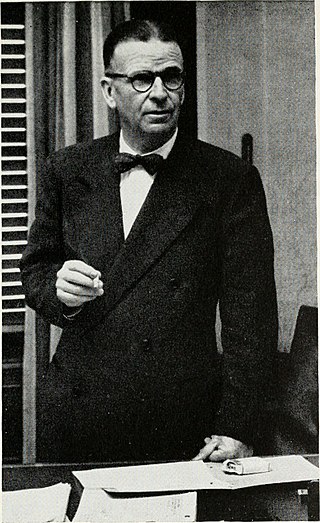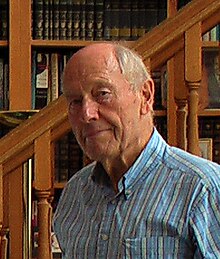
The Allan variance (AVAR), also known as two-sample variance, is a measure of frequency stability in clocks, oscillators and amplifiers. It is named after David W. Allan and expressed mathematically as . The Allan deviation (ADEV), also known as sigma-tau, is the square root of the Allan variance, .

IEEE 488, also known as HP-IB and generically as GPIB, is a short-range digital communications 8-bit parallel multi-master interface bus specification developed by Hewlett-Packard. It subsequently became the subject of several standards.
Louis Essen OBE FRS(6 September 1908 – 24 August 1997) was an English physicist whose most notable achievements were in the precise measurement of time and the determination of the speed of light. He was a critic of Albert Einstein's theory of relativity, particularly as it related to time dilation.

John Lewis "Jan" Hall is an American physicist, and Nobel laureate in physics. He shared the 2005 Nobel Prize in Physics with Theodor W. Hänsch and Roy Glauber for his work in precision spectroscopy.
Martin Allan Uman is an American engineer. He has been acknowledged by the American Geophysical Union as one of the world's leading authorities on lightning.

John Milton Miller was a noted American electrical engineer, best known for discovering the Miller effect and inventing fundamental circuits for quartz crystal oscillators.
IEEE 1451 is a set of smart transducer interface standards developed by the Institute of Electrical and Electronics Engineers (IEEE) Instrumentation and Measurement Society's Sensor Technology Technical Committee describing a set of open, common, network-independent communication interfaces for connecting transducers to microprocessors, instrumentation systems, and control/field networks. One of the key elements of these standards is the definition of Transducer electronic data sheets (TEDS) for each transducer. The TEDS is a memory device attached to the transducer, which stores transducer identification, calibration, correction data, and manufacturer-related information. The goal of the IEEE 1451 family of standards is to allow the access of transducer data through a common set of interfaces whether the transducers are connected to systems or networks via a wired or wireless means.
The IEEE Joseph F. Keithley Award in Instrumentation and Measurement is a Technical Field Award of the Institute of Electrical and Electronics Engineers (IEEE) that was established by the IEEE Board of Directors in 2001 and first awarded in 2004. It is named in honor of Joseph F. Keithley, the founder of Keithley Instruments, and it replaced the previous IEEE Morris E. Leeds Award, which was named in honor of Morris E. Leeds, an inventor of electrical measuring devices and controls. The award is presented annually for outstanding contributions in electrical measurements, and is sponsored by Keithley Instruments and the IEEE Instrumentation and Measurement Society.

David Jeffrey Wineland is an American Nobel-laureate physicist at the National Institute of Standards and Technology (NIST) physics laboratory. His work has included advances in optics, specifically laser-cooling trapped ions and using ions for quantum-computing operations. He was awarded the 2012 Nobel Prize in Physics, jointly with Serge Haroche, for "ground-breaking experimental methods that enable measuring and manipulation of individual quantum systems".

Keithley Instruments is a measurement and instrument company headquartered in Solon, Ohio, that develops, manufactures, markets, and sells data acquisition products, as well as complete systems for high-volume production and assembly testing.
Leonard Cutler (1928–2006), also known as Leonard S. Cutler, was a pioneer and authority on ultra-precise timekeeping devices and standards, and was well known for his work with quantum-mechanical effects. He was the co-inventor of the HP5060A Cesium Beam Clock, its successor the HP 5071A, and the two-frequency laser inferometer. He has also been praised for his crucial contributions to the design of the Allen Telescope Array.
Neil Ashby is an American physicist. He attended Dalhart High School, graduating in 1951. He received his B.A. degree in physics from the University of Colorado, Boulder, in 1955, and the M.S. and Ph.D. degrees from Harvard University, Cambridge, Massachusetts in 1956 and 1961, respectively. After spending a year in Europe as a postdoctoral fellow, he joined the faculty of the department of physics at the University of Colorado in 1962. He has been a professor of physics there since 1970, and was department chair from 1984 to 1988. He is currently professor emeritus – theoretical math-physics at the University of Colorado.

Mervin Joseph Kelly was an American industrial physicist. He worked at Bell Labs from 1925 to 1959, in which time he held positions such as director of research, president, and chairman of the board of directors.
A Josephson voltage standard is a complex system that uses a superconducting integrated circuit chip operating at a temperature of 4 K to generate stable voltages that depend only on an applied frequency and fundamental constants. It is an intrinsic standard in the sense that it does not depend on any physical artifact. It is the most accurate method to generate or measure voltage and has been, since an international agreement in 1990, the basis for voltage standards around the world.

Ursula Keller is a Swiss physicist. She has been a physics professor at the ETH Zurich, Switzerland since 2003 with a speciality in ultra-fast laser technology, an inventor and the winner of the 2018 European Inventor Award by the European Patent Office.
Thomas Edward Linnenbrink is an electrical engineer with the Hittite Microwave Corporation of Colorado Springs, Colorado. He was named a Fellow of the Institute of Electrical and Electronics Engineers (IEEE) in 2012 for his work in standards for instrumentation and measurement systems.
The Joseph F. Keithley Award For Advances in Measurement Science is an award of the American Physical Society (APS) that was first awarded in 1998. It is named in honor of Joseph F. Keithley, the founder of Keithley Instruments. The award is presented annually for outstanding contributions in measurement techniques and equipment, and is sponsored by Keithley Instruments and the Topical Group on Instrument and Measurement Science (GIMS).
Bryan Peter Kibble was a British physicist and a pioneering metrologist. He was the inventor of the Kibble balance, an improved version of the current balance, developed for the realisation of the S.I. unit of mass, the kilogram.
Time metrology or time and frequency metrology is the application of metrology for time keeping, including frequency stability. Its main tasks are the realization of the second as the SI unit of measurement for time and the establishment of time standards and frequency standards as well as their dissemination.








